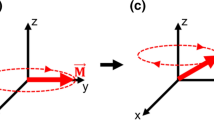Abstract
The use of an optical oxygen sensor to measure dissolved oxygen in seawater was investigated. The sensor is based on the dynamic quenching of an oxygen-sensitive fluorochrome embedded in the tip. Dissolved oxygen in seawater samples collected from eight stations at depths ranging from 3000 to 6000 m was analyzed both with the optical sensor and by the Winkler titration method. The two sets of data did not differ significantly. The stability and simplicity of the method and the good agreement of the results with those of the titration method indicate that the sensor would be useful for fieldwork.
Similar content being viewed by others
References
Atkinson, M. J., F. I. M. Thomas, N. Larson, E. Terrill, K. Morita and C. C. Liu (1995): A micro-hole potentiostatic oxygen sensor for oceanic CTDs. Deep-Sea Res. I, 42, 761–771.
Biddanda, B. and R. Benner (1997): Major contribution from mesopelagic plankton to heterotrophic metabolism in the upper ocean. Deep-Sea Res. I, 44, 2069–2085.
Emerson, S., C. Stump, B. Johnson and D. M. Karl (2002): In situ determination of oxygen and nitrogen dynamics in the upper ocean. Deep-Sea Res. I, 49, 941–952.
Furuya, K. and K. Harada (1995): An automated precise Winkler titration for determining dissolved oxygen on board ship. J. Oceanogr., 51, 375–383.
Klimant, I., V. Meyer and M. Kuhl (1995): Fiber-optic oxygen microsensors, a new tool in aquatic biology. Limnol. Oceanogr., 40, 1159–1165.
Peterson, J. I. R., V. Fitzgerald and D. K. Buckhold (1984): Fiber-optic probe for in vivo measurement of oxygen partial pressure. Anal. Chem., 56, 62–67.
Robinson, C., P. Serret, G. Gilstone, E. Teira, M. V. Zubkov, A. P. Ress and E. M. S. Woodward (2002): Plankton respiration in the Eastern Atlantic Ocean. Deep-Sea Res. I, 49, 787–813.
Stokes, M. D. and G. N. Somero (1999): An optical oxygen sensor and reaction vessel for high-pressure applications. Limnol. Oceanogr., 44, 189–195.
Voraberger, H. S., H. Kreimaier, K. Biebernik and W. Kern (2001): Novel oxygen optrode withstanding autoclavation: technical solutions and performance. Sens. Actuat., B74, 179–185.
Williams, P. J. L. and N. W. Jenkinson (1982): A transportable microprocessor-controlled precise Winkler titration suitable for field station and shipboard use. Limnol. Oceanogr., 27, 576–584.
Winkler L. W. (1888): Die Bestimmung des im Wasser gelosten Sauerstoffen. Ber. Dtsche. Chem. Ges., 21, 2843–2855.
Author information
Authors and Affiliations
Corresponding author
Rights and permissions
About this article
Cite this article
Hasumoto, H., Imazu, T., Miura, T. et al. Use of an optical oxygen sensor to measure dissolved oxygen in seawater. J Oceanogr 62, 99–103 (2006). https://doi.org/10.1007/s10872-006-0036-8
Received:
Revised:
Accepted:
Issue Date:
DOI: https://doi.org/10.1007/s10872-006-0036-8




